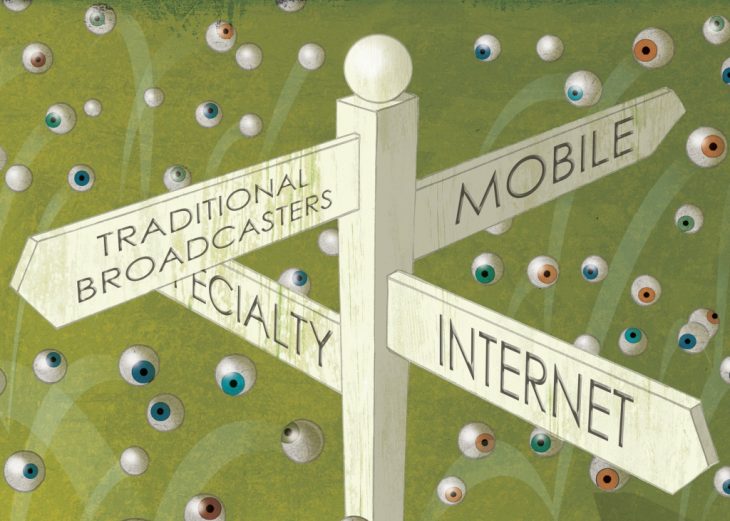
VANCOUVER – The speech CRTC chairman Jean-Pierre Blais gave yesterday to the Vancouver Board of Trade looked like a plea for Canadians to take a deep breath, step back, and let the Regulator do its work on the TV Policy Review – and to remind all that decisions will be based solely on the hard evidence presented to it.
Blais referenced the beginnings of the satellite TV era in Canada where the incumbent cable companies and others used the term Death Star to describe the potential newcomers. Back then, incumbents spoke of all manner of ruination that would come to Canadian TV if satellite television distribution companies were to launch. As others have done, Blais drew parallels between the fearful claims made then with the advent of new technology and the whinging going on now as technology continues its break-neck progress.
“The lesson to be drawn is that the CRTC will not find wise counsel in the rhetoric of today’s pundits and incumbents who have created new technological ‘death stars’ to scare the regulator into action or inaction. Nor should we embrace knee-jerk solutions to complex problems,” said Blais.
While many inside and outside of the industry believe over-the-top (OTT) video is on the cusp of not just upsetting, but completely crushing the Canadian TV applecart, Blais told listeners yesterday he believes that’s just not so.
“Let me bust a few myths,” he said. “Yes, some companies are losing subscribers. This is not a threat; this is precisely what one would expect in a competitive marketplace. According to our most recent data, the total number of subscribers to cable, satellite and Internet Protocol television (IPTV) service providers has gone down by 7,600 across Canada. That is a decrease of 0.1% in the span of a year. Compare that to the cord-cutting occurring in wireline telephony. In 2013, the number of residential telephone lines fell by 6%.”
And it’s not as though those cord-cutters are cutting themselves off. They all continue to have wireless and broadband subscriptions. In fact, most Canadians who choose to view OTT video do so in addition to paying for their usual TV bundle, he added, quoting Deloitte’s Duncan Stewart.
“And despite the mountain of media stories about Netflix, and Shomi, and HBO online, and CBS online and Bell’s Project Latte, let’s not lose sight of the fact that about 60% of Canadians do not stream TV programming. Canadians still watch on average 28 hours of traditional TV a week and the hours of viewing to online video services, including cute kittens on YouTube, is only 1.9 hours per week,” said Blais.
Despite the fact that there are some real changes going on, the CRTC must demand real, hard evidence when making policy decisions that affect the $62 billion Canadian communications industry and the customers who need those services – and avoid hasty decision making.
“If this is acting like a dinosaur, I will wear that label proudly.” – Jean-Pierre Blais. CRTC
“No one will benefit from a reckless regulator. If this is acting like a dinosaur, I will wear that label proudly,” said Blais.
Blais directly addressed the appearances by Google and Netflix at the Let’s Talk TV hearing in September (if not directly by name) where in the end, the evidence from both companies were stricken from the record for refusing the Commission’s demand for better evidence to show what the companies said they could see happening in Canada, was actually happening.
“You probably know we were criticized by some commentators over our demand that interveners provide the hard data we need to make informed regulatory decisions,” he explained. “I am not speaking about individual Canadians who appear at our hearings. I am speaking of two companies, with a total market cap of over $400 billion, which operate in Canada and filed positions in our hearing. Such parties cannot refuse to provide evidence without consequences, especially when they appear before an evidence-based decision maker. Like other administrative tribunals, we struck out their incomplete evidence.
“This is not about regulating them or not, as some uninformed casual observers would have you believe. This is about the integrity of an evidence-based proceeding… public policy cannot be based solely on unsubstantiated statements or on economic analysis advanced by technocrats.”
Sound public policy – even in the face of what looks on the surface to be an unprecedented amount, and pace, of change – must rely on data, on evidence and careful consideration of everything brought forward, and not all the surrounding noise.
“Good decisions cannot be based on anecdotes about how your teenager is using his smartphone or gaming system.” – Blais
“Good decisions cannot be based on anecdotes about how your teenager is using his smartphone or gaming system either. Neither can we make informed decisions based on one-sided blog arguments or 140 characters in the Twitterverse. Nor is it helpful when think tanks and pundits weigh in from the sidelines, often after our hearings have occurred,” said Blais.
“If we were to make decisions based on the latest fad or unverified assumptions, we would find ourselves on a very short pier, rather than an intelligent bridge towards the ‘change’ destination on the other shore. And we would risk doing irreparable harm to the sectors of the economy we oversee, as well as to the quality, reliability and affordability of the communication services Canadians rely on.”
CRTC decisions are only as good as the evidence gathered, much of it given on the “stage” that is the Commission hearing room, said the chairman. While different players shine different lights in different places during their appearances, very often self-interested lights, it lets the Commission examine every corner of the stage. “Some lanterns are skewed to obscure the truth. Others are very dim (but we listen nevertheless). And the very small lanterns of thousands of individual Canadians often create a powerful beam of light,” said Blais. “It’s only when the stage is fully illuminated, by all those lanterns, that the full story becomes clear. It is only then that the full public interest comes to light.”
Despite the worry about the effect Netflix may be having on the system, and sometimes general rancour towards the possibility of regulating it and other OTT providers (and a federal government which has already directly told the Commission and all Canadians it will not stand for such a move), the CRTC will make its own decision on this, the chairman reiterated.
“Regulating Netflix is the least of our concerns.” – Blais
“Regulating Netflix is the least of our concerns,” he said. “Whether we choose to attack these disruptive services or learn from their success will be our regulatory decision to make and ours alone.”
Besides, the Regulator is looking at so many things right now – and not just TV. It also held a wireless proceeding in September on wholesale roaming and will hold another later this month on third party access to fibre plant built by the incumbent telcos and cablecos. Both of those proceedings are about delivering much-needed connectivity, sometimes lifeline services, and helping grow the digital economy.
“If you think this is about House of Cards and Orange is the New Black,” said the chairman, “you are missing the point about the breadth of potentially disruptive digital issues on the horizon.”



